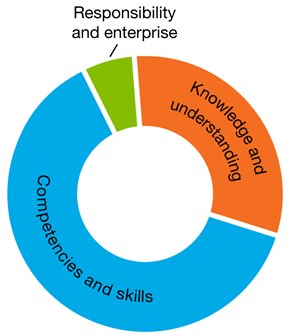Explore content
English
The Australian Curriculum: English has an important role in developing consumer and financial literacy in young people. The English curriculum develops students’ understanding of how to read, view and interpret texts. Through the literacy strand of the curriculum, students learn to understand the full range of texts that they need to work with in school and broader community contexts. The English curriculum supports the development of the following dimensions of consumer and financial literacy.

Approximate proportion of dimensions addressed in English
The study of English enables students to construct meaning from different texts and to evaluate how text structures, images and language features influence readers and viewers. These skills are underlined by the understanding students develop about how language varies depending on the formality of social interactions, and how the choice of language and text structures is influenced by audience and purpose. These key principles support students to read, view, listen to and interpret a range of financial texts and critically analyse the ways in which marketers and advertisers manipulate consumers. When given opportunities to deconstruct these texts, students can become more knowledgeable about and develop a deeper understanding of their behaviour as consumers.
The content descriptions that relate to consumer and financial literacy have been drawn from the language and literacy strands. Only those content descriptions with explicit links to consumer and financial literacy have been included in the mapping. Other content descriptors that provide opportunities have been mapped to the Literacy general capability. The literature strand has not been included in this mapping. However, there are opportunities to include this strand when students engage with literary texts that focus on a consumer or financial theme, such as ASIC’s digital big book Ava makes a difference and story resources supporting the Years 1, 2 and 3 Mathematics units, or when narrative is identified as a tool to promote consumer or financial products.
Moneysmart for teachers and Tax, Super and You provide a number of interdisciplinary units and interactive activities that either focus on or include aspects of the English curriculum. Access a list of relevant resources that link to the Australian Curriculum: English using the right-hand menu.
Years F-2 Digital activity – Ava makes a difference
Years F-2 Digital activity – Goods and services
Years F-2 Digital activity – Needs and want
Year 3 The house of needs and wants
Year 4 How much love can fit into a shoebox?
Years 2-4 Digital activity – Money and people
Years 2-4 Digital activity – Money maps
Year 5 Never too young to be Moneysmart with clothes
Digital activity – MilbaDjunga – Smart Money – Primary Unit
Year 6 The fun begins: Plan, budget, profit!
Year 6 It’s raining cats and dogs... and chickens?
Years 5-8 Digital activity – Mobile phone security
Years 5-6 Digital activity – Calls, messaging and browsing
Years 5-6 Digital activity – Choosing a mobile plan
Years 5-6 Digital activity – Entertainment
Year 6 Digital activity – The cost of cats and dogs…and snakes
Year 7 Should I drink bottled water?
Year 7 How can we reduce our spending?
Year 8 How can we access money overseas?
Years 5-8 Digital activity – Mobile phone security
Years 7-8 Digital activity – Advertising
Years 7-8 Digital activity – Premium services
Years 7-8 Digital activity – Social media
Years 7-8 Digital activity – Consumer rights
Years 8-9 MilbaDjunga SmartMoney – Secondary unit
Year 9 How can we obtain more money?
Year 9 English – smart consumers 4 a smart future – Smart arguments
Year 9 Mathematics – smart consumers 4 a smart future – Solar sums
Year 9 Digital activity – Savvy solutions to consuming questions
Years 9-10 – MoneySmart Rookie – First car
Years 9-10 – MoneySmart Rookie – Credit and debt
Years 9-10 – MoneySmart Rookie – Mobile phone ownership
Years 9-10 – MoneySmart Rookie – Moving out of home
Years 9-10 – MoneySmart Rookie – Online financial transactions
Years 9-10 – MoneySmart Rookie – First job
Years 9-10 Digital activity – Shopping for a mobile
Years 9-10 Digital activity – Online shopping and banking
Year 10 English – Teens talk money
Year 10 English – smart consumers 4 a smart future – Green house rules
Year 10 Mathematics – smart consumers 4 a smart future – Money matters
Year 10 Science – smart consumers 4 a smart future – Decisions by the stars
Years 7-10 Tax 101: Activity 1 – What is tax and why do we need it?
Years 7-10 Tax 101: Activity 3 – How is tax revenue spent?
Years 7-10 Tax 101: Activity 5 – History of tax in Australia
Years 7-10 Tax 101: Activity 6 – Role of the ATO
Years 7-10 Your Tax: Activity 1 – Income and income tax
Years 7-10 Your Tax: Activity 2 – Working and paying tax
Years 7-10 Your Tax: Activity 3 – Completing your tax return
Years 7-10 Your Tax: Activity 6 – Fixing a tax problem
Years 7-10 Business Tax: Activity 2 – Business structures
Years 7-10 Business Tax: Activity 3 – Running a business: tax obligations
Years 7-10 Super: Activity 1 – What is superannuation?
Years 7-10 Super: Activity 3 – What do I need to do about super?
Years 7-10 Super: Activity 4 – How do I choose a super fund?
Purpose audience and structures of different types of texts
Understand that authors innovate with text structures and language for specific purposes and effects (ACELA1553)
Visual language
Analyse and explain the use of symbols, icons and myth in still and moving images and how these augment meaning (ACELA1560)
Comprehension strategies
Use comprehension strategies to interpret and analyse texts, comparing and evaluating representations of an event, issue, situation or character in different texts (ACELY1744)
Analysing and evaluating texts
Explore and explain the combinations of language and visual choices that authors make to present information, opinions and perspectives in different texts (ACELY1745)

